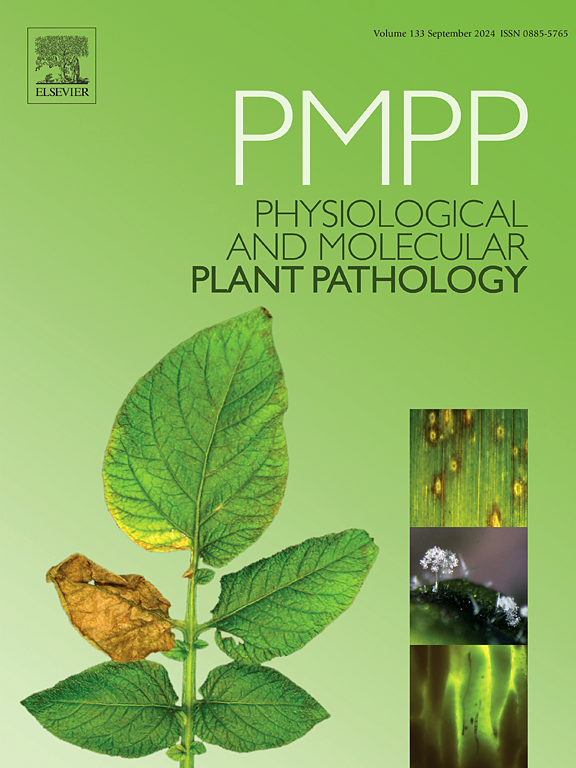Bacillus velezensis YN2111 reveals the potential role of amine oxidase in Fusarium wilt response in Cavendish bananas
IF 2.8
3区 农林科学
Q2 PLANT SCIENCES
引用次数: 0
Abstract
Fusarium wilt of banana (FWB)—a soil-borne disease caused by Fusarium oxysporum f. sp. cubense (Foc) especially tropical race 4 (TR4)—poses a significant threat to the banana industry. Biological control is a primary strategy for preventing and controlling FWB. In this study, we isolated Bacillus velezensis YN2111 and found that YN2111's metabolic composition exhibits biocontrol properties, including promoting banana growth and inhibiting TR4 in vitro. However, greenhouse pot experiments and laser scanning confocal microscopy revealed that YN2111 can exacerbate FWB by facilitating the entry of TR4 into the plant roots. We speculate that a specific interaction exists among YN2111, Cavendish banana, and TR4. To explore this interaction, we conducted transcriptome sequencing of 64 banana root samples under four different treatments (CK, YN2111, TR4, and YN2111+TR4) at four time points. We subsequently identified a key gene through STEM analysis of DEGs, which encodes a banana amine oxidase (containing copper) involved in the catabolism of polyamines, designated as MuAo (TPM <1). This gene was cloned, and subsequently RT-qPCR results showed that the Ct values of MuAo in samples treated with YN2111 were similar to those in the negative control (using a water template), suggesting that YN2111 treatment effectively inhibited MuAo expression. Combining RT-qPCR results with further inference from literatures, the MuAo may be related to the basal defense of banana, we concluded that YN2111 can block the expression of MuAo in banana roots, suggesting that MuAo could potentially be involved in the process by which YN2111 facilitates the entry of TR4 into the banana roots. Finally, we discussed a novel interaction among YN2111, banana, and TR4, with the outcomes of this research offering a better understanding of Bacillus spp. in biocontrol and microbial-plant interactions, and providing new insights into the exploration of resistance genes against FWB.
velezensis YN2111揭示了胺氧化酶在卡文迪什香蕉枯萎病反应中的潜在作用
香蕉枯萎病(Fusarium wilt of banana, FWB)是一种由香蕉枯萎病(Fusarium oxysporum f. sp. cubense, Foc),特别是热带4号种(TR4)引起的土传疾病,对香蕉产业构成重大威胁。生物防治是预防和控制FWB的主要策略。在本研究中,我们分离到了velezensis YN2111,发现YN2111的代谢成分在体外具有促进香蕉生长和抑制TR4的生物防治特性。然而,温室盆栽实验和激光扫描共聚焦显微镜发现,YN2111可以通过促进TR4进入植物根系而加剧FWB。我们推测YN2111与卡文迪什香蕉和TR4之间存在特定的相互作用。为了探索这种相互作用,我们在4个时间点对4个不同处理(CK、YN2111、TR4和YN2111+TR4)下的64个香蕉根样品进行了转录组测序。随后,我们通过对DEGs的STEM分析发现了一个关键基因,该基因编码一种参与多胺分解代谢的香蕉胺氧化酶(含铜),命名为MuAo (TPM <1)。克隆该基因后,RT-qPCR结果显示,经YN2111处理的样品中MuAo的Ct值与阴性对照(采用水模板)相似,表明YN2111处理有效抑制了MuAo的表达。结合RT-qPCR结果和文献进一步推断,MuAo可能与香蕉的基础防御有关,我们认为YN2111可以阻断MuAo在香蕉根中的表达,提示MuAo可能参与了YN2111促进TR4进入香蕉根的过程。最后,我们讨论了YN2111与香蕉和TR4之间的新型互作,本研究结果为更好地了解芽孢杆菌在生物防治和微生物-植物相互作用中的作用提供了新的认识,并为探索抗FWB的抗性基因提供了新的见解。
本文章由计算机程序翻译,如有差异,请以英文原文为准。
求助全文
约1分钟内获得全文
求助全文
来源期刊
CiteScore
4.30
自引率
7.40%
发文量
130
审稿时长
38 days
期刊介绍:
Physiological and Molecular Plant Pathology provides an International forum for original research papers, reviews, and commentaries on all aspects of the molecular biology, biochemistry, physiology, histology and cytology, genetics and evolution of plant-microbe interactions.
Papers on all kinds of infective pathogen, including viruses, prokaryotes, fungi, and nematodes, as well as mutualistic organisms such as Rhizobium and mycorrhyzal fungi, are acceptable as long as they have a bearing on the interaction between pathogen and plant.

 求助内容:
求助内容: 应助结果提醒方式:
应助结果提醒方式:


